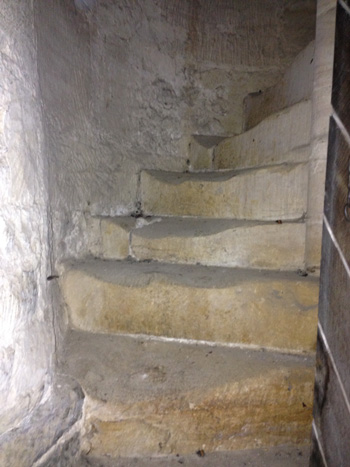Worn Tower Steps
This article is from the website of the Bath and Wells Diocese, to whom we offer our thanks.
Stone stairways are often among the last remaining undisturbed elements of the original fabric of an ancient tower; their wear patterns are likely to have historical significance. However, having regard to Health and Safety legislation, it is important that stairways are maintained in a safe condition.
General Precautions:-
- Hand support is important for safety: eg. a rope around the central newel or circumference·
- Adequate safe lighting should be provided
- Safety is improved and wear minimised by regular sweeping·
- A lack of general precautions may jeopardise insurance cover·
Survey:-
- Steps should be numbered and inspected individually·
- Repairs should be specified in detail so as to achieve a minimum alteration to original fabric·
Slight wear:-
If improvement is really necessary for safety reasons, a suitable mortar infill to minor depressions might be employed; the mortar repair should be visually distinguishable and trimmed to avoid feather edges.·
Significant wear:-
Possible solutions include:· - Where treadwear is considerable, the structural condition may also need to be assessed and it might be necessary to form complete, new wearing surfaces; This should still be achieved with a minimum of intervention. ·
- Timber casing, which is seldom to be recommended due to a tendency to become loose and a vulnerability to beetle attack·
- Deep mortar filling which will require keying or bonding to the treads·
If structural improvement is required, fine concrete or granolithic overtreads incorporating nominal reinforcement might be suitable·
In every case, care needs to be taken to avoid creating dangerously unequal consecutive risers, or reducing the headroom unacceptably. Where new material is cast over a step, it should be trimmed before setting to show clearly the wear profile on the riser.
The lowest repaired step should be dated.·
The need for action and the choice of repair method must be assessed carefully in the light of the circumstances of each particular case. Detailed specifications will be required and the church architect or surveyor should be instructed at an early stage.
Faculty consent will be necessary for any significant repair or improvement works.
The steps at Chilton Cantelo have been described as, "More like a slide than steps"! The ringers would like to have them repaired, but the quote that they have had is £2,500. For a church in a such a tiny village, this is a huge amount to have to find.



